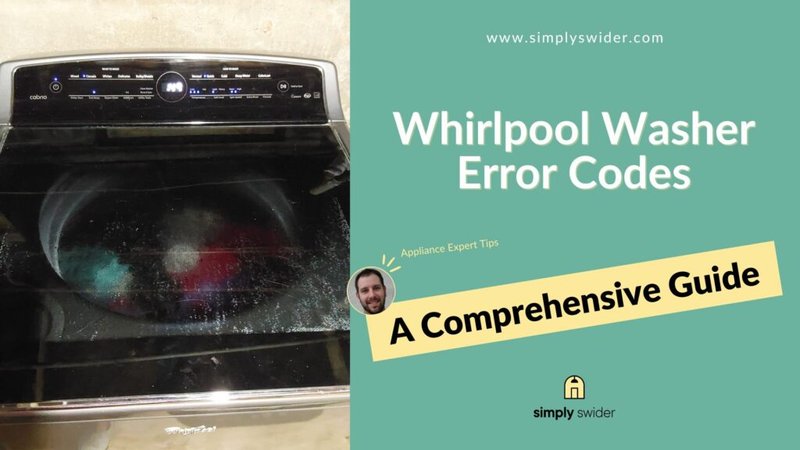
Now, you might be wondering why this happens in the first place. The E3 error typically points to a problem somewhere in the system that heats the water. This could involve several components, each playing a vital role. It’s not just a random glitch but a sign that something needs attention. Understanding what’s behind this error can help you figure out how to fix it and get your dishwasher back in action.
Understanding Error Code E3
The heart of your dishwasher’s ability to clean effectively is its heating component. Think of it like trying to clean a pot without warm water — you wouldn’t get very far. The E3 error code indicates that your dishwasher is struggling to heat the water to the correct temperature to ensure your dishes come out sparkling clean. This could be due to various reasons, ranging from a faulty heating element to issues with the thermostat or a malfunctioning control board. Each of these components has a specific role in ensuring that the water is heated appropriately during the wash cycle.
When we delve into the specifics, it’s crucial to realize that a malfunction in the heating element is akin to having a broken heater in the middle of winter — it just can’t warm things up as it should. Similarly, if the thermostat is not working right, it’s like a broken thermostat in your home that can’t register temperatures correctly. These analogies help illustrate why your dishwasher might not be functioning properly. You see, a dishwasher relies heavily on the heated water, and without it, dishes won’t be sanitized and stains won’t break down as effectively.
So, if you’re seeing that E3 code, it’s a sign that the heating process is not being completed. This can result in dishes that aren’t properly cleaned and potential hygiene issues. Here’s the deal: addressing this problem promptly is essential to maintain the efficiency and hygiene of your dishwasher.
Possible Causes of the E3 Error Code
Identifying the cause of the E3 error code involves understanding your dishwasher’s inner workings. One of the most common reasons for this error is a faulty heating element — that’s the part of the dishwasher responsible for actually doing the warming up. Imagine it’s like trying to cook on a stovetop that won’t heat up no matter how high you turn the dial. Without the heating element working correctly, the dishwasher simply can’t function as intended.
Another potential culprit is the temperature sensor, or the thermostat, which monitors the water’s temperature during the cycle. If this sensor is faulty, it’s akin to having a broken thermometer that can’t tell if your oven is at 350 degrees or 150 degrees. Without accurate readings, the dishwasher can’t adjust the heating process properly, which results in the E3 error on your machine.
Lastly, the control board, which acts like the brain of the dishwasher, could be malfunctioning. This board coordinates all functions, including the heating, and if it’s on the fritz, it might not signal the heater to turn on at the right time or for the appropriate duration. Think of it as a miscommunication during a team project — if directions aren’t clear, the work just doesn’t get done right.
Steps to Fix the E3 Error
So, what should you do when faced with this pesky error code? First and foremost, it’s important to not panic — this is generally a fixable issue. Begin by checking the heating element. You’ll want to ensure that it’s getting the power it needs and there are no visible signs of damage or disconnection. Much like checking your car battery when the car won’t start, ensuring the power supply is intact is critical.
If the heating element appears fine, your next step should be to test the temperature sensor. This might require the use of a multimeter to check for continuity, ensuring it can effectively read the water temperature. If the sensor is broken, replacing it is often the best course of action to restore full functionality.
Lastly, if neither the heating element nor the sensor is the issue, it might be time to look at the control board. Troubleshooting or replacing a control board can be a bit more complex, as it involves ensuring all the connections are secure and checking for any fried circuits or obvious damage.
Preventative Tips
Prevention is always better than cure, and taking some care can help avoid encountering the E3 error in the first place. Regular maintenance can go a long way in keeping your dishwasher running smoothly. Think of it like regular oil changes for your car — necessary for preventing future breakdowns. Routinely inspect the heating element for signs of wear, and ensure the thermostat is functioning correctly.
Moreover, it’s wise to run a cleaning cycle with dishwasher cleaner every month. This helps remove any build-up that could affect the sensors or the heating element itself. Another tip is to ensure that the dishes inside aren’t blocking the spray arms or sensors, as incorrect loading can disrupt the cycle and lead to ineffective heating.
Having a good user manual on hand for reference is a smart move as well. It can be your best friend when trying to troubleshoot or understand why an error has appeared. Being proactive with these steps can save you time, money, and the hassle of dealing with error codes down the line.
And there you have it! By understanding what the E3 error code means and how to address it, you’re well on your way to keeping your Whirlpool dishwasher functioning at its best. Remember, a little maintenance goes a long way in ensuring all your dishwashing needs are met without a hitch.